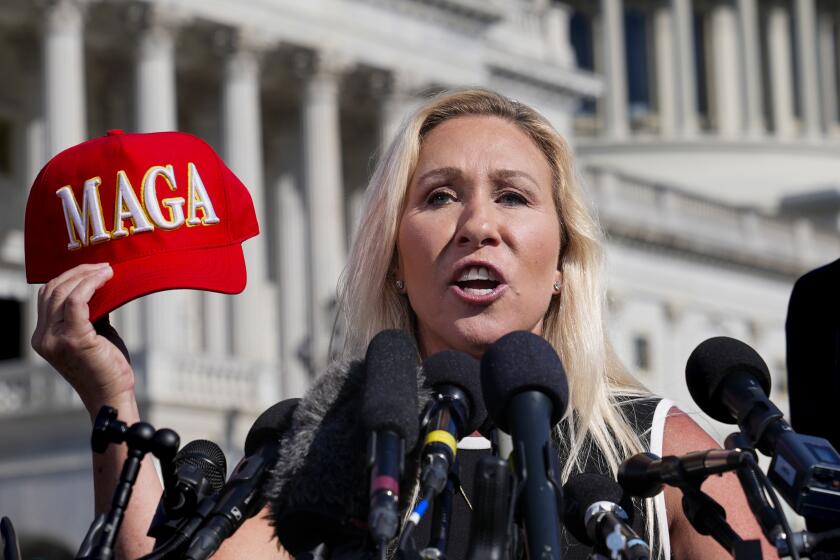Benefits Tab Seen as Major Fiscal Drag
The state government has guaranteed health benefits for tens of thousands of its current and future retirees without a plan to pay for them, and the liability threatens to return California to fiscal crisis, the Legislature’s lead fiscal analyst said Friday.
The nonpartisan legislative analyst’s office reported that the bill for workers already promised lifetime health insurance by the state is $40 billion to $70 billion over the next 30 years. And that sum is rising rapidly as more state workers become eligible. The price tag could trump even the cost of the $68-billion bond measure at the center of Gov. Arnold Schwarzenegger’s proposal to build roads, bridges, levees, jails and courthouses.
School districts, public universities and city and county governments are expected to face a similar tab of combined expenses. In the Los Angeles Unified School District alone, unfunded healthcare costs have reached $10 billion. Paying for them could eat up as much as one-fifth of the system’s budget.
“The bottom line is we are talking about a substantial amount of money,” said Jason Dickerson, who wrote the report for the analyst’s office. “It is going to become increasingly difficult to find funds to pay for this.”
Concerns on Wall Street that state and local governments had no plan to cover their healthcare obligations prompted new federal regulations requiring them to project those costs. The report released in Sacramento on Friday was a product of those new rules.
California’s government is just one of hundreds of bureaucracies across the country being forced to confront their healthcare expenses. Some have already taken action to deal with the problem, building and investing reserve funds.
New York City, facing $50 billion in healthcare debt, recently set aside $2 billion to begin building such a fund. Maryland, with a $20-billion tab, is setting aside $100 million annually, and a task force there has advised lawmakers to increase the amount.
Friday’s news is more evidence that government inaction on the issue will come at a huge cost to taxpayers, said some who advocate scaled-back state pension benefits. Last year, Schwarzenegger launched a ballot initiative intended to lower the state’s costs by moving new government workers off fixed pension plans.
Fixed-plan costs have escalated substantially in recent years, and the governor wanted to move state workers into 401(k)-style investment plans favored by private industry.
Schwarzenegger abandoned that proposal after the state attorney general’s office said the measure could cost police and firefighters their death and disability benefits.
Since then, there has been little movement in Sacramento toward reining in benefits costs.
“This issue has been ignored for years, and now it is coming home to roost,” said Assemblyman Keith Richman (R-Northridge).
Lawmakers and administration officials appeared taken off-guard by Friday’s report. They responded by announcing plans to study the issue.
“We need a comprehensive examination of the public pension system in California by a nonpartisan commission,” Senate leader Don Perata (D-Oakland) said in a statement. The governor has called for such a commission, but it has yet to be formed.
Perata said Democrats in the upper house remain opposed to proposals like the governor’s earlier plan.
“Anyone who seeks to use this report to abandon the teachers, cops and firefighters who have worked their lives for the people of this state will be disappointed,” his statement said.
Vince Sollitto, a spokesman for the governor, said the administration has proposed that $252,000 be allocated for a report that pinpoints the amount California will owe in coming years.
Sollitto said it may be impractical for the state to create a reserve fund to cover the costs while California is still expected to spend many billions of dollars more every year than it takes in.
“It’s difficult to save for future liabilities when you are not yet even able to pay for your current expenses,” he said.
State workers have healthcare benefits that are becoming increasingly rare in the private sector. Only 32% of large California corporations offer their retirees health benefits.
Employees of the state for 10 years or more and their eligible family members receive at least some health benefits for life. After 20 years, they are fully covered. Depending on the plan the employee is enrolled in, those who are fully covered may pay no out-of-pocket premiums.
The cost to the state of providing these benefits has tripled in the last decade.
Union officials said Friday’s report should not cause alarm. Most state workers are unionized.
“This is not a crisis,” said Dave Low, a lobbyist with the union-backed California Families Against Privatizing Retirement.
“Everybody has always known these obligations exist. Just because an accounting board in Washington has decided things need to be reported differently, that does not make what was not a crisis yesterday a crisis today.”
Low said the state can head off problems by setting aside money now to pay for future costs.
The report said the state would need to set aside an average of $6 billion a year for the next 30 years to cover the costs. That would amount to roughly 5% of all state spending next year.
More to Read
Get the L.A. Times Politics newsletter
Deeply reported insights into legislation, politics and policy from Sacramento, Washington and beyond. In your inbox three times per week.
You may occasionally receive promotional content from the Los Angeles Times.







